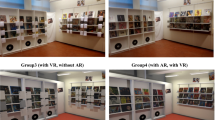Abstract
The awareness of self-position, which refers to the location of our cyclopean eye, is essential to the experience of being immersed and for interacting with a virtual environment. Currently, individual variability in the cyclopean eye location is not considered when presenting virtual reality content. The effect of the cyclopean eye shift was analyzed with theoretical and experimental methods, and it was found that human vision is sensitive to the visual direction offset caused by the cyclopean eye shift. To compensate for the cyclopean eye shift, an original model is proposed with shifting the 3D camera system accordingly. The proposed method is expected to make all individuals with different cyclopean eye shifts perceive the virtual environment from the same viewpoint as the designer desired and may achieve more accurate interaction.





Similar content being viewed by others
References
Barbeito R (1982) The cyclopean eye vs. the sighting-dominant eye as the center of visual direction. Percept Psychophys 32(3):201–210
Barbeito R, Ono H (1979) Four methods of locating the egocenter: a comparison of their predictive validities and reliabilities. Behav Res. Methods Instrum 11(1):1–6
Fry GA (1950) Visual perception of space. Am J Optom 27(11):531–553
Funaishi S (1926) Weiteres über das Zentrum der Sehrichtungen. Albr von Graefes Arch für Ophthalmol 117(2):296–303
Heinrich SP, Kromeier M, Bach M, Kommerell G (2005) Vernier acuity for stereodisparate objects and ocular prevalence. Vis Res 45(10):1321–1328
Hering E (1879/1942) Spatial sense and movements of the eye (trans: Radde CA). American Academy of Optometry, Baltimore, MD (Original work published in 1879)
Hou C, Kim Y, Verghese P (2017) Cortical sources of Vernier acuity in the human visual system: an EEG-source imaging study. J Vis 17(6):2–1–12
Howard IP, Templeton WB (1966) Human spatial orientation. Wiley, London
Interrante V, Höllerer T, Lécuyer A (2013) Virtual and augmented reality. IEEE Comput Graph Appl 38(2):28–30
Jin L, Boev A, Egiazarian K, Gotchev A (2014) Quantifying the importance of cyclopean view and binocular rivalry-related features for objective quality assessment of mobile 3D video. EURASIP J Image Video Process 2014(6):1–18
Kishi S, Abe N, Shibata T, Kawai T, Maeda M, Hoshi K (2009) Stereoscopic camera system with creator-friendly functions. In: Stereoscopic displays and applications XX, 72371M
Marsh W, Kelly J, Dark V, Oliver J (2016) Presence in virtual reality and everyday life: immersion within a world of representation. Presence Teleoper Virtual Environ 25(2):169–174
Reichelt S, Häussler R, Fütterer G, Leister N (2010) Depth cues in human visual perception and their realization in 3D displays. In: Three-dimensional imaging, visualization, and display 2010 and display technologies and applications for defense, security, and avionics IV, vol 7690. International Society for Optics and Photonics, 76900B
Roelofs CO (1959) Considerations on the visual egocentre. Acta Psychol (Amst) 16:226–234
Steuer J (1992) Defining virtual reality—dimensions determining telepresence. J. Commun 42(4):73–93
Turski J (2016) On binocular vision: the geometric horopter and cyclopean eye. Vis Res 119:73–81
Urey H, Chellappan KV, Erden E, Surman P (2011) State of the art in stereoscopic and autostereoscopic displays. Proc IEEE 99(4):540–555
van de Grind WA, Erkelens CJ, Laan AC (1995) Binocular correspondence and visual direction. Perception 24(2):215–235
Walls GL (1951) A theory of ocular dominance. AMA Arch Ophthalmol 45(4):387–412
Woods A, Docherty T, Koch R (1993) Image distortions in stereoscopic video systems. Stereosc Disp Appl IV 1519:36–49
Xia Z, Peli E (2018) Cyclopean eye based binocular orientation in virtual reality. In: SID symposium digest of technical papers, pp 381–384
Acknowledgements
This research is supported by the China Scholarship Council (CSC file No. 201704515003) and by the National Eye Institute of the National Institutes of Health under award number P30EY003790.
Author information
Authors and Affiliations
Corresponding author
Additional information
Publisher's Note
Springer Nature remains neutral with regard to jurisdictional claims in published maps and institutional affiliations.
Rights and permissions
About this article
Cite this article
Xia, Z., Hwang, A. Self-position awareness-based presence and interaction in virtual reality. Virtual Reality 24, 255–262 (2020). https://doi.org/10.1007/s10055-019-00396-8
Received:
Accepted:
Published:
Issue Date:
DOI: https://doi.org/10.1007/s10055-019-00396-8




